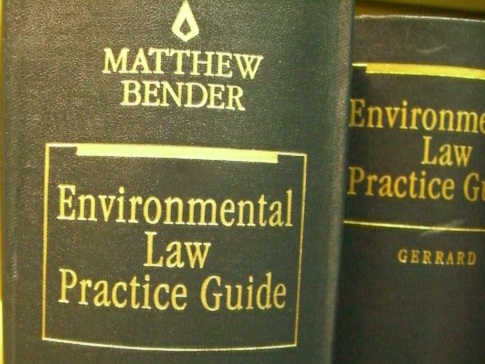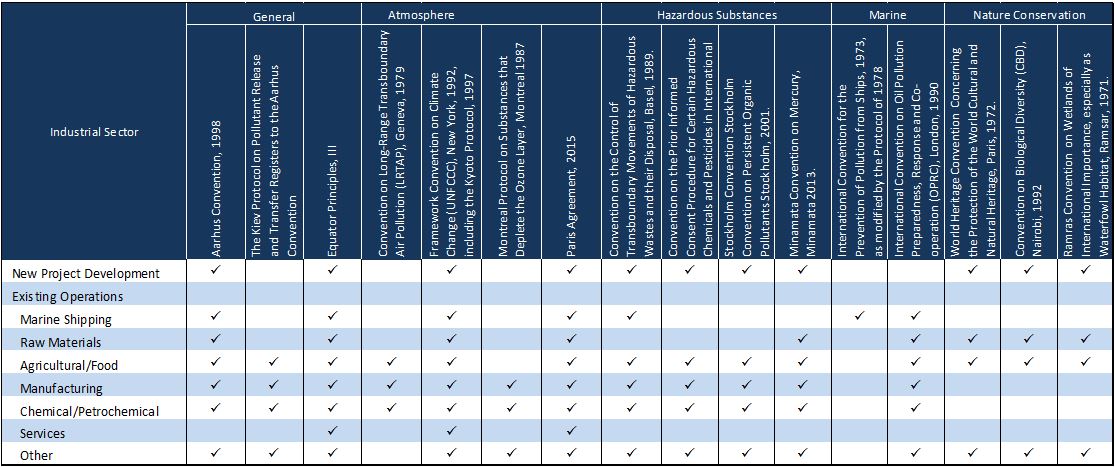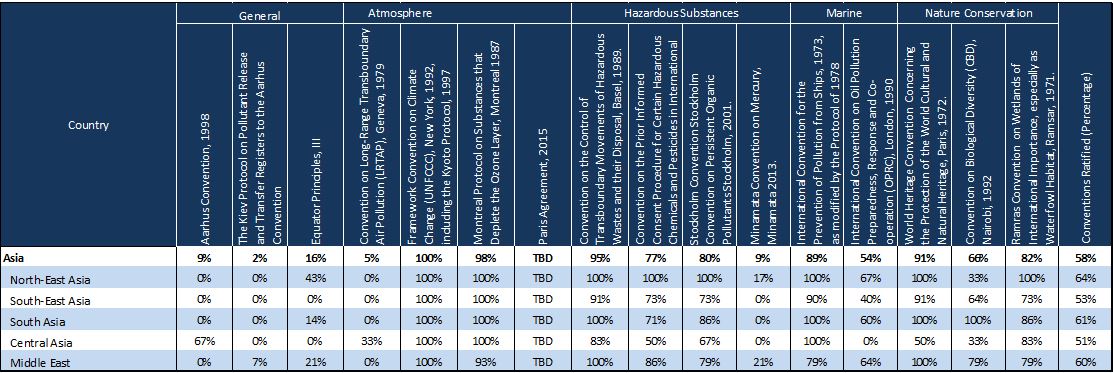In a previous blog, I presented a broad overview of national environmental laws in Asia and the Middle East. In this post I will follow up on that theme and discuss key international environmental agreements that apply to businesses operating in Asia. This issue of international environmental agreements is particularly timely in light of the recent Paris Agreement for the first ever universal, legally binding global climate deal.
But, before we get into the details of which agreements are important to the HSE professional in Asia, let's first review some of the jargon used in this field (definitions are primarily as used by the EU).
| Term | Definition |
|---|---|
| Accession | Act whereby a State becomes a Party to an international agreement already negotiated and closed for signature. Accession has the same legal effect as ratification, although an acceding State has not signed the agreement. |
| Acceptance or Approval | The "acceptance" or "approval" of a treaty have the same legal effect as ratification and consequently express the consent of a state to be bound by a treaty. |
| Agreement | a. Generic term for an international legally binding instrument. In this sense, encompasses several instruments, such as treaties, conventions, protocols or other forms of agreements. b. May also be used as a specific term to designate international instruments that are “less formal”, thus corresponding to soft law and deal with a narrower range of subject-matter than treaties |
| Bilateral Agreements | An agreement between two states which is only legally binding for these two states with the benefits typically not shared with other (third) countries. Note that there are literally thousands of such agreements between countries in Asia and some of these may directly or indirectly affect HSE issues. Key ones for the HSE professional to be aware of are typically associated with some form of trade agreements, which often have HSE clauses included. We are not discussing bilateral agreements in this blog post. |
| Binding | An instrument that entails an obligation (usually for States) under international law. |
| Compliance | Fulfillment by a Party of its obligations under an international agreement. |
| Conventions | a. Generic term for an international legally binding instrument between a member state of an international body (e.g., International Labour Office) and the international body. b. May also be used as a specific term; now is generally used for formal multilateral treaties with a broad number of parties. Conventions are normally open for participation by the international community as a whole, or by a large number of states. Usually the instruments negotiated under the auspices of an international organization are entitled conventions (e.g. Convention on Biological Diversity of 1992). The same holds true for instruments adopted by an organ of an international organization (e.g. the 1981 ILO Safety and Health Convention). |
| Declarations | The term "declaration" is used for various international instruments. However, declarations are not always legally binding. The term is often deliberately chosen to indicate that the parties do not intend to create binding obligations but merely want to declare certain aspirations. An example is the 1992 Rio Declaration. |
| Multi-lateral Agreements | An agreement to which three or more sovereign states are parties. Each party owes the same obligations to all other parties, except to the extent that they have stated reservations. |
| Protocol | The term used for agreements less formal than those entitled treaty or convention. |
| Ratification | The international act whereby a state indicates its consent to be bound to an agreement. |
| Treaties | (a) The term treaty has regularly been used as a generic term embracing all instruments binding at international law concluded between international entities, regardless of their formal designation. In order to speak of a "treaty" in the generic sense, an instrument has to meet various criteria. First of all, it has to be a binding instrument, which means that the contracting parties intended to create legal rights and duties. Secondly, the instrument must be concluded by states or international organizations with treaty-making power. Thirdly, it has to be governed by international law. Finally the engagement has to be in writing. (b) Treaty as a specific term: There are no consistent rules when state practice employs the terms "treaty" as a title for an international instrument. Usually the term "treaty" is reserved for matters of some gravity that require more solemn agreements. The use of the term "treaty" for international instruments has considerably declined in the last decades in favour of other terms. |
Multilateral Environmental Agreements (MEAs) have existed for more than a century and are often divided into the “traditional era” (preceding the 1972 UN Stockholm Conference on the Human Environment), the “modern era” from Stockholm to the 1992 UN Conference on Environment and Development in Rio de Janeiro, and the “post-modern era“ following Rio.1 Most of the MEAs in place and relevant today are ones developed post 1972 Stockholm Conference.
The proliferation of MEAs (not to mention bilateral agreements) has raised many issues regarding the complexity and lack of synergy in these international laws. For instance, according to International Environmental Agreements (IEA) Database Project there are over 1100 multilaterals, 1500 bilaterals, and 250 "other" legally-related international environmental agreements!
While this makes work for lawyers, fortunately, for the HSE professional few of these have any direct impact on your day-to-day activities
Do We Really Need to be Concerned About Multilateral Environmental Agreements?
That's a good question.
In short, for most of these agreements – no.
This is because in international law, there is no general rule that companies are responsible for their internationally wrongful acts; rather, multilateral agreements generally impose obligations on states, not on companies.2
But, some long-standing multilateral treaties do directly impose obligations on companies. For instance, the 1969 Convention on Civil Liability for Oil Pollution Damage provides that the owner of a ship (which may be a company) shall be liable for any pollution damage caused by it.
And, in other cases the international agreements are enforced within the national legal system, so it is prudent of you to be aware of these agreements and their potential impacts on your operations.
What International Multilateral Environmental Agreements Do I Need to Be Aware Of?
Below are some of the key MEAs that potentially affect your business, along with a very brief description of each one.
Table 1: Overview of Key MEAs and Private Sector Obligations
| Agreement | Description and Private Sector Requirements |
|---|---|
| Aarhus Convention, 1998 | • ensures opportunities for citizens to access environmental information are increased and transparent and reliable regulation procedure is secured • indirect impacts on private enterprise by regulators requirement to release private sector environmental performance information to the public |
| The Kiev Protocol on Pollutant Release and Transfer Registers to the Aarhus Convention, 2003 | • the first legally binding international instrument on Pollutant Release and Transfer Registers (PRTRs) • PRTRs are inventories of pollution from industrial sites and other sources such as agriculture and transport • places indirect obligations on private enterprises to report annually to their national governments on their releases and transfers of pollutants |
| Equator Principles III, 2013 | • a risk management framework, adopted by financial institutions, for determining, assessing and managing environmental and social risk in project. • currently 81 Equator Principles Financial Institutions in 36 countries have officially adopted the EPs, covering over 70 percent of international Project Finance debt in emerging markets • affects new project development with respect to increased levels of environmental and social assessments, mitigation measures and environmental performance monitoring; can also apply to financing of ongoing operations |
| Convention on Long-Range Transboundary Air Pollution (LRTAP), Geneva, 1979 | • aims to limit and, as far as possible, gradually reduce and prevent air pollution including long-range transboundary air pollution • has been extended by eight specific protocols • places indirect obligations on private enterprises to report annually to their national governments on their releases and transfers of pollutants |
| Framework Convention on Climate Change (UNFCCC), New York, 1992, including the Kyoto Protocol, 1997 | • objective is to "stabilize greenhouse gas concentrations in the atmosphere at a level that would prevent dangerous anthropogenic interference with the climate system" • no binding limits on greenhouse gas emissions were set for individual countries and it contains no enforcement mechanisms • now superseded by the Paris Agreement |
| Montreal Protocol on Substances that Deplete the Ozone Layer, Montreal 1987 | • legally binding reduction goals for the use of CFCs, the main chemical agents causing ozone depletion • resulted in wide-spread elimination of consumption and production of controlled ozone depleting substances |
| Paris Agreement, 2015 | • core elements of the agreement include commitments on emissions, adaptation, finance and transparency, and steps to promote carbon trading • impact of private industry, especially those in energy intensive operations, expected to be significant as carbon reduction laws are promulgated |
| Convention on the Control of Transboundary Movements of Hazardous Wastes and their Disposal, Basel, 1989 | • designed to reduce the movements of hazardous waste between nations, and specifically to prevent transfer of hazardous waste from developed to less developed countries (LDCs) • affects private sector via disposal options for hazardous waste |
| Convention on the Prior Informed Consent Procedure for Certain Hazardous Chemicals and Pesticides in International Trade, Rotterdam, 1998 | • the convention promotes open exchange of information and calls on exporters of hazardous chemicals to use proper labeling, include directions on safe handling, and inform purchasers of any known restrictions or bans • indirect impacts on private industry via changes in national laws of hazardous chemicals and labeling requirements |
| Stockholm Convention on Persistent Organic Pollutants Stockholm, 2001 | • aims to eliminate or restrict the production and use of persistent organic pollutants (POPs) • indirect impacts on private industry via changes in national laws of POPs and banning of 21 POPs, e.g., dioxin, DDT, toxaphene |
| Minamata Convention on Mercury, Minamata 2013 | • designed to protect human health and the environment from anthropogenic emissions and releases of mercury and mercury compounds • products containing mercury, and their production and trade will be altogether prohibited by 2020, e.g., batteries, compact fluorescent lamps, switches and relays, soaps and cosmetics, thermometers, and blood pressure devices will have significant impacts on industry/businesses that use mercury in production process or results in significant emissions of mercury |
| International Convention for the Prevention of Pollution from Ships, 1973, as modified by the Protocol of 1978 relating thereto (MARPOL 73/78), London 1973 and 1978 | • developed to minimize pollution of the oceans and seas, including dumping, oil and air pollution • objective is to preserve the marine environment in an attempt to completely eliminate pollution by oil and other harmful substances and to minimize accidental spillage of such substances • places many requirements on marine ships |
| International Convention on Oil Pollution Preparedness, Response and Co-operation (OPRC), London, 1990 | • establishing measures for dealing with marine oil pollution incidents nationally and in co-operation with other countries • applies specific requirements to vessels, offshore installations, ports |
| World Heritage Convention Concerning the Protection of the World Cultural and Natural Heritage, Paris, 1972 | • it links together in a single document the concepts of nature conservation and the preservation of cultural properties • of particular relevance for private sector with respect to new project development in areas that might affect World Heritage Sites |
| Convention on Biological Diversity (CBD), Nairobi, 1992 | • the convention recognized for the first time in international law that the conservation of biological diversity is "a common concern of humankind" and is an integral part of the development process • links traditional conservation efforts to the economic goal of using biological resources sustainably • sets principles for the fair and equitable sharing of the benefits arising from the use of genetic resources, notably those destined for commercial use • covers the rapidly expanding field of biotechnology through its Cartagena Protocol on Biosafety, addressing technology development and transfer, benefit-sharing and biosafety issues • the Convention is legally binding; countries that join it ('Parties') are obliged to implement its provisions and as such has direct and indirect implications to private sector • of particular relevance for private sector with respect to new project development in areas that might biological diversity |
| Ramsar Convention on Wetlands of International Importance, especially as Waterfowl Habitat, Ramsar, 1971 | • applies to the for the conservation and sustainable utilization of wetlands, recognizing the fundamental ecological functions of wetlands and their economic, cultural, scientific, and recreational values • of particular relevance for private sector with respect to new project development in areas that might affect wetlands |
Is My Business Affected By These Agreements?
Yes. Quite possibly, either directly or indirectly, depending upon the type of business, types of material/chemicals/wastes handled/produced, air emissions, wastewater effluents, energy usage, location, country of operation, etc.
If your company is sourcing new project financing from one of the private financial institute that is party to the Equator Principles, then you will also be bound by those requirements, which focus on responsible environmental and social management practices consistent with requirements of Performance Standards of the International Finance Corporation (IFC), the global benchmark for environmental and social risk management for the private sector. Note that these requirements are much more comprehensive than required in almost all national environmental regulators and permitting agencies in Asia.
Other MEAs are new, e.g., Minamata Convention on Mercury and Paris Agreement on Climate Change, and these will almost certainly affect private sector as these are ratified and come in force over the next few years. I will discuss these emerging issues in more detail in future blog posts.
Below, the key MEAs are summarized with respect to their possible applicability to types of industry. You are encouraged to download the actual documents and review these agreements in more detail to determine if and how they might affect your business.
Table 2: Private Sector Type Potentially Affected by Key MEAs
Across Asia, the level of ratification of many of these MEAs is very high - overall nearly 60% of the these key conventions have been ratified. There is little variability in the rate of ratification among regions, ranging from a low of 51% in Central Asia to 64% in North-East Asia.
Table 3: Ratification of Key Multilateral Environmental Agreements
The Kyoto Protocol (climate change), Montreal Protocol (ozone), Basel Convention (hazardous waste), Stockholm Convention (persistent organic compounds), Marpol (waste management for ships), World Heritage Convention (protected areas), and Ramras Convention (wetlands) have all be ratifed by 80% or more of the countries in Asia.
For further details of which countries have ratified these agreements, please download the following pdf file:
Table 4: Ratification of Key MEAs in Asia - by Country
Take Home Messages
- There are number of Multilateral Environmental Agreements (MEAs) that are potentially applicable to businesses operating in Asia.
- These agreements may or may not be legally binding and may or may not directly affect your business.
- Key MEAs that are in place today and have wide ranging implications on business operating n Asia include those related to hazardous waste management (Basel Convention) and Marpol (for ship wastes).
- Key emerging MEAs that will potentially affect many businesses in Asia include the Minamata Convention on Mercury and the Paris Agreement on climate change.
- For new project development, the increasing environmental and social due diligence of financial institutes is forcing much more comprehensive environmental and social assessments and management plans than required by most countries in Asia.
Thanks for reading. Keep safe. Be healthy. Respect your environment.
I hope that you will bookmark the blog, share it with your colleagues and visit the blog frequently because you find it informative and helpful. I value your feedback and suggestions for future topics.
Please enter your email in the box at the top of the post and subscribe to our blog HSE Asia - our weekly blog will be emailed directly to you.
Next Week’s Blog Topic: Legislation or Prosperity – What Drives HSE Performance?
Photo Credits: Environmental Law books photo courtesy of umjanedoan at flicker.com under Creative Commons license
- Is Your Business Compliant with HSE Regulations? Take Our Quiz to Find Out! - September 16, 2024
- Duty of Care: What it Is and What it Means to Companies Operating in the GCC? - January 28, 2024
- Free E-Book:Health, Safety, and Environment Regulatory Review – United Arab Emirates: An Overview of Federal Requirements - July 5, 2023
- Sand P.H. 2007. Ch. 2 The Evolution of International Environmental Law. In Bodansky et al. Ed. The Oxford Handbook of International Law. Oxford. Oxford University Press. 2007.
- Professor Menno T. Kamminga, Professor of International Law, Maastricht University; Co-Director, Maastricht Centre for Human Rights. Paper presented at the 71st Conference of the International Law Association, plenary session on Corporate Social Responsibility and International Law, Berlin, 17 August 2004.



It’s a relief to find soneome who can explain things so well
Thank for reading Joyce and glad you found it useful.